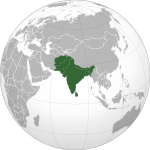Kanva Dynasty | |||||||||||||
|---|---|---|---|---|---|---|---|---|---|---|---|---|---|
| 73 BCE–28 BCE | |||||||||||||
 Kanvayana shown with other petty kingdoms of that time, along with the large kingdoms of the Satavahanas and Indo-Scythians. | |||||||||||||
| Capital | Pataliputra and Vidisha | ||||||||||||
| Common languages | Sanskrit | ||||||||||||
| Religion | Hinduism | ||||||||||||
| Government | Monarchy | ||||||||||||
| Emperor | |||||||||||||
• 73–64 BCE | Vasudeva Kanva (first) | ||||||||||||
• 38–28 BCE | Susarman (last) | ||||||||||||
| History | |||||||||||||
• Established | 73 BCE | ||||||||||||
• Disestablished | 28 BCE | ||||||||||||
| |||||||||||||
| History of India |
|---|
 |
| Timeline |
| History of South Asia |
|---|
 |
The Kanva dynasty or Kanvavamsha was the sixth ruling dynasty of Magadha, established after Vasudeva Kanva overthrew the preceding Shunga dynasty and ruled from 73 BCE to 28 BCE.[1][2]
Although the Puranic literature indicates that the Kanvas ruled from the former capital of the Shungas in Pataliputra, Magadha in Eastern India, their coins are primarily found in and around the region of Vidisha in Central India,[3] which had also been the capital of later Shunga rulers.[4]
The Kanva dynasty was established by Vasudeva Kanva in 73 BCE. Vasudeva was initially a minister of the Shunga Emperor Devabhuti, who then assassinated the former emperor and usurped the throne.[5] The Kanva ruler allowed the kings of the Shunga dynasty to continue to rule in obscurity in a corner of their former dominions. There were four Kanva rulers. According to the Puranas, their dynasty was brought to an end by the Satavahanas in 28 BCE.[6][2]